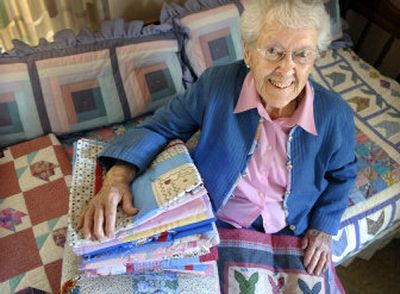Handmade quilts cover others with warmth

Early in her quest to make quilts for the needy, Olive Harrison was warned by her mother that it was impractical “to keep the world warm.”
“I know,” Harrison replied, “but I can try.”
And try she did, to the tune of 1,200 quilts, all handmade, for premature infants clinging to life at Sacred Heart Hospital, for the down and out at Anna Ogden Hall, for children Harrison suspected had never had anything they could truly call their own.
There is something poignant about providing quilts to people seemingly on the verge of falling through the cracks. Quilts by composition are the sewn tatters from the fabric basket. They have been made from the last usable remains of tired shirts and old dresses, of cloth scraps that just happened to lie on the wrong side of a tailor’s shears.
They’re the kind of scraps for which a society constantly moving on to the next thing has little use. When Harrison learned from her mother-in-law how to quilt 70 years ago, the world was different. The Great Depression was on. Unemployment was at an all-time high of 19 percent, and areas like the Inland Northwest, dependant on farming, mining and logging, were hit particularly hard. Back then they wouldn’t have dreamed of spending money on something as extravagant as a blanket. In a sense, quilting was a way of stitching lives back together, a means of crafting something from nothing, sometimes for warmth, sometimes for income.
Transforming scraps into warm gifts for the down and out, the left behind, has been a good calling for Harrison, at least until recently.
Harrison is 93. She lives independently in the same Millwood home she and her husband, Faris, picked out more than 60 years ago, the very home in which they raised four children. A while ago she broke her right wrist while trying to catch herself from falling over backward.
She’s lost some mobility as a result of the break. Whether she quilts again depends on how much use of the hand she can regain. When quilting is on her mind, you can see her turning her right wrist, working her fingers, attempting to loosen everything up for more production.
Harrison has three women who help her quilt. Like her, they’re all members of St. Pascal Roman Catholic Church in Millwood. However, she’s the one who stitches the pieces together. The whole quilting operation is based out of Harrison’s basement.
“She’s the one that has the great big table in her basement, and she lays out the quilts and makes the patterns,” said Barbara Vermillion, who helps out. “All we do is tie them.”
If this is truly the end of the line, then the quilts are likely to stop arriving at hospitals and shelters without anyone even knowing who was making them. Harrison takes no credit, though Vermillion and the other two women who help out, Monica Schoen and Delores Fuchs, have suggested Harrison label the gifts so people know from the where quilts came. Harrison would hear nothing of it.
She hasn’t so much as met any of the recipients of her craftwork, which puzzles some. One friend who learned what Harrison was up to, suggested that she was being taken for granted. That some of the quilts she was sewing were being given to people who likely sold them for drug money.
But as she stitches, Harrison doesn’t see things that way. She thinks of the infants too weak to handle daylight who need to be covered from head to toe. She thinks of children assured that when they wrap up at night in the quilt that Harrison made, it is theirs alone.
“I prefer to take that view,” she said.